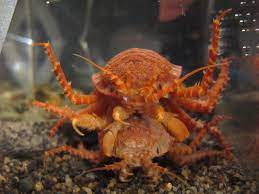The beach includes over 70Percent in the Earth’s surface, with only 5% of this looked into. This has generated quite a few interesting breakthroughs worldwide of underwater animals. Some of those is definitely the giant isopod, which is among the same loved ones since the common woodlouse. Though they are not particularly gorgeous, Giant isopods are some of the most exciting creatures based in the depths in the ocean. In this post, we shall investigate the interesting realm of Giant isopods and why is them stand out from the remainder of the serious-water creatures.
1. Giant isopods Qualities: Giant isopods are a kind of crustacean that could mature to 2 and a one half toes long and weigh approximately four pounds. There is a squashed, oblong-formed entire body separated into three specific sectors – the head, the thorax, and also the stomach. Their most noteworthy function is the piercing eye, which stay on the top of stalks that allow them to observe their prey or predator without transforming their heads. Giant isopods have powerful, razor-sharp claws that allow them to smash and consume even most challenging of seashells.
2. Habitat: Giant isopods are located in the deeply-water, all around 1,000 to 8,000 ft . beneath the area. They can be usually discovered near hydrothermal vents, which offer the required nutrients such as microorganisms. They are most frequently based in the Atlantic, Pacific, and Indian Oceans, where water is colder, as well as the strain is higher. Because of the depth in which they are living, little is famous concerning their reproduction or life cycle.
3. Behavior: Giant isopods are slow-shifting creatures that tend to keep hidden from the rocks or sediment on the seafloor. These are night critters, which means these are most productive at night and often cover up during the day. They may be scavengers and prey on lifeless animals that slip for the seafloor, as well as are living organisms they capture because of their strong jaws. They may live for some time without meals and have been proven to make it through over 4 years without ingesting.
4. Relevance: Despite the fact that Giant isopods are certainly not commercially beneficial, they play a crucial role inside the sea ecosystem. These are an important source of food for other deeply-seas critters, which include crabs, sharks, and sea food. Their reputation indicates the healthiness of strong-ocean ecosystems, that could have sustained effects around the world’s oceans and climate. Simply because 50 percent in the oxygen we inhale arises from the seas, it is vital to learn and protect these ecosystems and also the critters that live in them.
5. Preservation: However, small is famous concerning the populace of Giant isopods, as well as their deeply-ocean habitat will make it hard to research them or their ecosystem. Global warming, deep-ocean mining, and overfishing present a significant hazard to such beings and the deeply-seas ecosystems, which makes protecting them even more essential. Consequently, it is important to ensure defensive measures are put in place, and endeavours are supposed to save these interesting beings and be sure which they, in addition to their distinctive ecosystems, continue to succeed down the road.
To put it briefly
The giant isopod can be a exciting creature which is still simply being investigated, therefore we have so much to understand with this deeply-sea creature. As the oceans hold many miracles, it is crucial to protect the uncommon, interesting, and essential ecosystems that exist strong below the surface area. It depends on us to safeguard them and make certain that they carry on and prosper for generations to come to experience.
